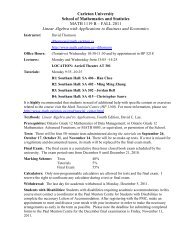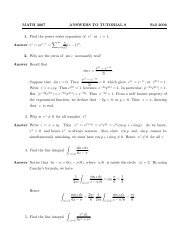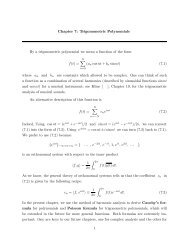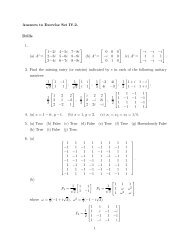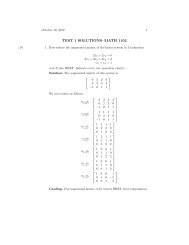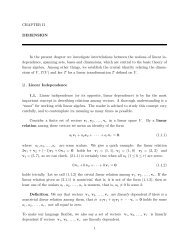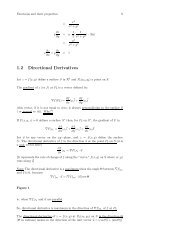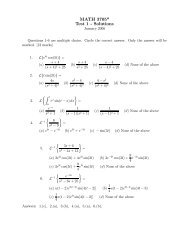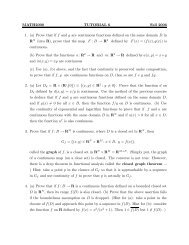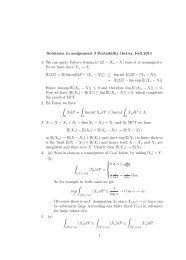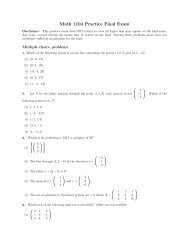Research Statement - Carleton University
Research Statement - Carleton University
Research Statement - Carleton University
Create successful ePaper yourself
Turn your PDF publications into a flip-book with our unique Google optimized e-Paper software.
production planning, manufacturing, and financial engineering. Due to the increasing complexity of<br />
the real-world scenarios, one is often forced to deal with large-scale systems. Due to the uncertainty<br />
of the random environment, there is a growing interest in modeling, analysis, and optimization of<br />
large-scale systems using a regime-switching model in addition to the usual dynamic systems.<br />
For the random sequences under consideration, there are two main issues. Firstly, not much<br />
structure of the sequence {X(k, αk)} is known. Secondly, for a large |M|, there are |M| sequences<br />
of {X(k, α)} with α ∈ M to be dealt with and the complexity becomes an important issue.<br />
Among the large number of states of a Markov chain, a typical situation is that transitions<br />
among some of the states are changing rapidly, whereas others are varying slowly. The state space<br />
can often be split into smaller subspaces such that within each subspace the transitions are about<br />
the same rate, and from one subspace to another, the transitions happen relatively rarely. More<br />
precisely, suppose the state space M admits the representation M = M1 ∪ · · · ∪ Ml0<br />
so that Mi,<br />
i = 1, . . . , l0, can be considered as subspaces, where the Mi’s are not isolated. Such a model is<br />
known to have nearly completely decomposable structure [7, 39] in the literature. A systematic<br />
study of the related Markovian models has been taken recently [45].<br />
Using two-time scales in the formulation, we introduce a small parameter ε > 0 into the transition<br />
probabilities so as to highlight the different rates of transitions. Then, we can write the<br />
sequence as X(k, α ε k ). We assume for each α, {X(k, α)} is mixing, and {αε k<br />
} is a discrete Markov<br />
chain with nearly completely decomposable structure. Due to the lack of structure of the multiple<br />
random sequences, the problem is difficult to solve. Using the idea of aggregation, we lump the<br />
states of the Markov chain in each Mi into one state for i = 1, . . . , l0 to get an aggregate process αε k .<br />
Corresponding to this, we consider a new sequence X(k, αε k ). Effectively, we use a single sequence<br />
{X(k, i)} as a representative for the sequences {X(k, α)} for all α ∈ Mi.<br />
We aim to demonstrate that the new sequence leads to a limit under suitable interpolations.<br />
The limit process is a switching diffusion with a well-defined operator. Denote the original state<br />
space and the state space of the limit by M and M, respectively. If |M| ≫ |M|, a substantial<br />
reduction of computational complexity will be achieved when one treats control and optimization<br />
problems.<br />
In the literature, treating discrete sequences, under suitable scaling, one may obtain a diffusion<br />
limit, which is the classical weak sense functional central limit theorem known as Donsker’s<br />
invariance principle. One may also be interested in obtaining the rates of convergence of the scaled<br />
sequence commonly referred to as strong invariance principle results. In what follows, our effort to<br />
obtain asymptotic properties of the underlying processes under suitable scaling will be described<br />
in more detail.<br />
2.1 Weak Convergence<br />
For ε > 0, let αε k be a time-homogeneous Markov chain on a probability space (Ω, F, P ) with state<br />
space M and transition matrix Pε = P + εQ, where P = (pij) is a transition probability matrix<br />
and Q = (qij) is a generator of a continuous-time Markov chain (i.e., pij ≥ 0 and ∑m j=1 pij = 1;<br />
qij ≥ 0 for i ̸= j and ∑m j=1 qij = 0 for each i). Assume that the state space M can be written as<br />
M = {s11, . . . , s1m1 } ∪ · · · ∪ {sl01, . . . , sl0ml 0 } = M1 ∪ · · · ∪ Ml0 ,<br />
with m0 = m1 + · · · + ml0 and P = diag[P 1 , . . . , P l0 ], where the subspace Mi consists of recurrent<br />
states belonging to the ith ergodic class and the transition probability matrix P i is irreducible and<br />
aperiodic, i = 1, . . . , l0.<br />
) the<br />
Let pε k be the probability vector, pε k = (P (αε k = sij)) ∈ R1×m0 , and νi = (νi1, . . . , νimi<br />
stationary distribution corresponding to the transition matrix P i . Assume that pε 0 = p0 and define<br />
4



